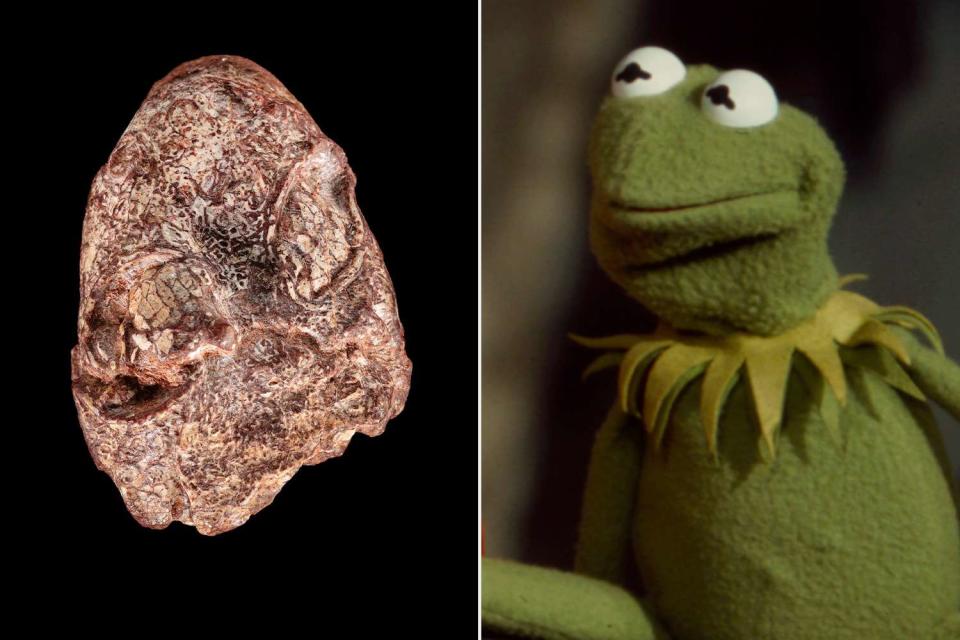Kermit the Frog Inspires Name of New Ancient Amphibian Species Discovered by Researchers
Scientists at the Smithsonian identified a fossilized skull from a 270 million-year-old amphibian, which they've named Kermitops gratus

Smithsonian;Getty
Kermitops gratus and Kermit the FrogScientists have found a previously undiscovered ancient amphibian species — and named it in honor of one of the most famous frogs of all time.
In a new research paper published Thursday in the Zoological Journal of the Linnean Society, scientists working with the Smithsonian National Museum of Natural History announced that they had identified a fossilized skull from a 270 million-year-old amphibian with wide eyes and a wide mouth. The newly discovered "proto-amphibian" will be named Kermitops gratus after the Muppets character Kermit the Frog.
According to the scientists, naming the prehistoric species after an iconic frog like Kermit is a way to bridge the gap between historians, researchers and the general public.
“Using the name Kermit has significant implications for how we can bridge the science that is done by paleontologists in museums to the general public,” Calvin So, a doctoral student at George Washington University and the lead author on the research paper, said in a press release. “Because this animal is a distant relative of today’s amphibians, and Kermit is a modern-day amphibian icon, it was the perfect name for it.”
Related: Billions of Cicadas Are Coming amid Rare Double Brood — See Where the Bugs Will Be This Spring
The name, of course, stems from Jim Henson's original 1955 Muppets character, and the Greek suffix “-ops,” meaning face. Much like Kermit, scientists said that the Kermitops had massive, cartoonish eyes. The species name "gratus" was selected in honor of the late paleontologist Nicholas Hotton III, who worked at the Smithsonian and made several trips to dig at the north central Texas site where the skull was found.
According to the researchers, the first clue they had that they had discovered an unknown frog species came in 2021, when postdoctoral paleontologist at the Smithsonian Arjan Mann spotted the mysterious-looking skull in a shipment of fossils from the Texas dig site.
"One fossil immediately jumped out at me — this really well preserved, mostly prepared skull," Mann, a co-author on the paper, said in the release.
Never miss a story — sign up for PEOPLE's free daily newsletter to stay up-to-date on the best of what PEOPLE has to offer, from celebrity news to compelling human interest stories.
The Kermitops gratus' skull was unlike other prehistoric frog genus, the scientists said, which helped them determine that it didn't belong to an already-known creature.
This recently studied skull had a much smaller section for its eyes than its snout, the researchers said, which may have allowed the animal — which "likely resembled a stout salamander" — to catch tiny insects.
Related: Rare Pygmy Hippo Birth at Athens Zoo Has Staff 'Absolutely Thrilled': 'Extremely Important'
Researchers also noted that this new discovery is essential to studying how modern amphibians came into being — as well as how their prehistoric ancestors looked and behaved. They concluded that the Kermitops gratus' fossil was a temnospondyl, or "a diverse group of primitive amphibian relatives that lived for over 200 million years from the Carboniferous to the Triassic periods."
“Kermitops offers us clues to bridge this huge fossil gap and start to see how frogs and salamanders developed these really specialized traits,” So added.
"This is an active area of research that a lot more paleontologists need to dive back into," Mann said in the press release. "Paleontology is always more than just dinosaurs, and there are lots of cool evolutionary stories and mysteries still waiting to be answered. We just need to keep looking."
For more People news, make sure to sign up for our newsletter!
Read the original article on People.

